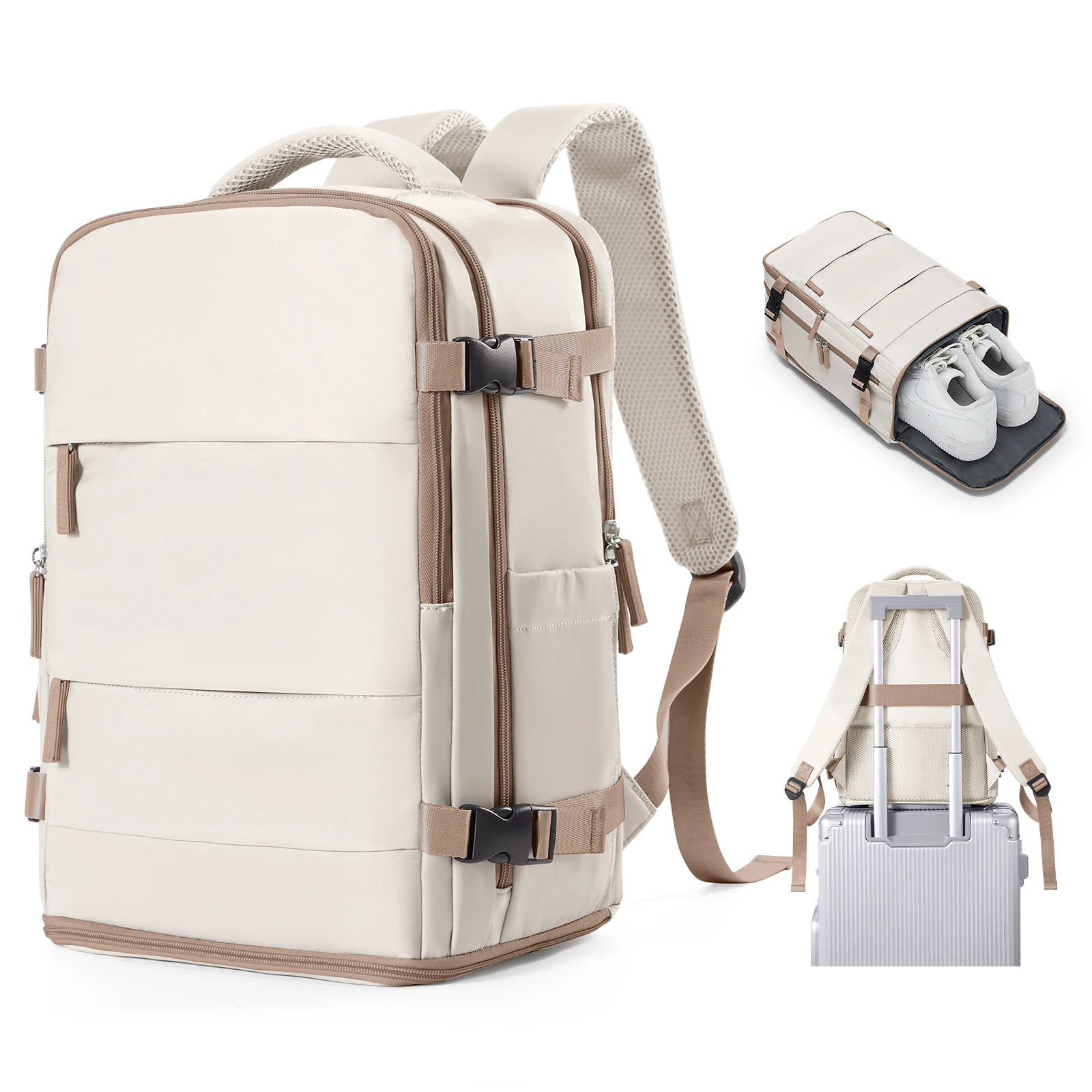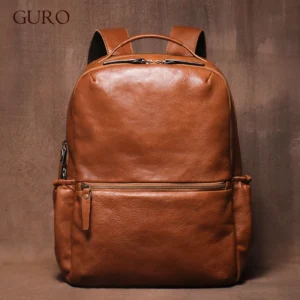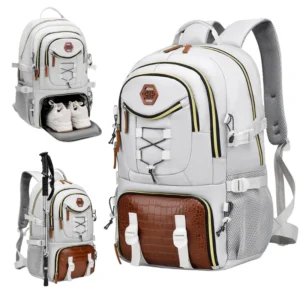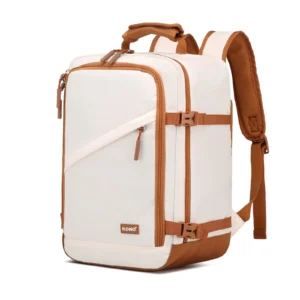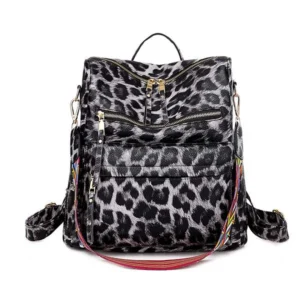Introduction: Navigating Travel With Your Leather Carry-On Backpack
Traveling with a leather backpack combines sophistication with practicality. Premium leather travel bags offer unmatched durability, professional aesthetics, and a timeless appeal that improves with age. However, navigating airline regulations with these bags presents unique challenges that many travelers face.
The main hurdles when traveling with leather travel backpacks include:
- Weight considerations – leather is naturally heavier than synthetic materials
- Dimensional compliance with varying airline requirements
- Proper measurement techniques for soft-sided leather bags
- Balancing style with practical travel functionality
Nearly 47% of travelers have faced unexpected gate check fees due to non-compliant bags, with leather carry-ons being particularly susceptible to size scrutiny. Understanding the exact requirements can help you avoid these costly surprises and travel more confidently.
This comprehensive guide will walk you through airline requirements, measurement techniques, material considerations, and practical selection tips to ensure your leather backpack stays with you in the cabin, not in the cargo hold.
Airline Carry-On and Personal Item Regulations
Understanding the difference between carry-on bags and personal items is crucial for traveling with leather backpacks. Carry-on bags are your main piece of luggage stored in overhead bins, while personal items are smaller bags that must fit under the seat in front of you.
Airlines typically measure bags using the concept of “linear inches” – the sum of a bag’s length, width, and height. Premium cabin passengers often enjoy more generous allowances, but the basic dimensional requirements remain relatively standardized.
The specific rules for leather carry-on backpacks vary by airline, but understanding common patterns helps you stay compliant across carriers.
Major Airline Carry-On Requirements Comparison
| Airline | Carry-On Max Dimensions | Personal Item Max Dimensions | Weight Limit | Special Notes |
|---|---|---|---|---|
| American | 22” × 14” × 9” | 18” × 14” × 8” | No published limit | Must fit in sizer |
| Delta | 22” × 14” × 9” | 18” × 14” × 8” | No published limit | Soft-sided bags may receive flexibility |
| United | 22” × 14” × 9” | 17” × 10” × 9” | No published limit | Strictly enforced at gates |
| Southwest | 24” × 16” × 10” | 18.5” × 8.5” × 13.5” | No published limit | Most generous dimensions |
| JetBlue | 22” × 14” × 9” | 17” × 13” × 8” | No published limit | May weigh bags at check-in |
| British Airways | 22” × 18” × 10” | 16” × 12” × 6” | 51 lbs (23 kg) | Weight strictly enforced |
| Air France | 21.7” × 13.8” × 9.9” | 16” × 12” × 6” | 26 lbs (12 kg) | Weight restrictions on all tickets |
| Lufthansa | 21.7” × 15.7” × 9” | 15.7” × 11.8” × 3.9” | 17.6 lbs (8 kg) | Weight strictly enforced |
| Emirates | 22” × 15” × 8” | 18” × 14” × 7” | 15 lbs (7 kg) | Economy weight restriction |
| Singapore Airlines | 22” × 15.7” × 7.9” | 15.7” × 11.8” × 3.9” | 15.4 lbs (7 kg) | Among the strictest weight limits |
Linear inches calculation is simple: add the length, width, and height measurements. For example, a 22” × 14” × 9” bag equals 45 linear inches. Most domestic carriers allow 45-50 linear inches, while international carriers may be stricter.
This framework of regulations forms the foundation for understanding how to properly measure and select a leather backpack for air travel.
How to Properly Measure Your Leather Backpack
Accurately measuring your backpack is critical for avoiding gate check surprises. Leather backpacks present unique challenges due to their flexible nature and potentially protruding elements.
Follow these steps to properly measure your backpack:
Prepare the backpack properly:
– Fill with typical travel items to account for expansion
– Secure all straps and compression systems
– Close all pockets and compartments fullyMeasure length (height):
– Stand the backpack upright on a flat surface
– Measure from the bottom to the highest point, including any handle
– For floppy tops, measure to where the bag naturally rests when fullMeasure width:
– Measure the backpack at its widest point when filled
– Include side pockets if they’re rigid or filled
– For tapered designs, measure at the widest sectionMeasure depth:
– Measure from front to back at the deepest point
– Include front pockets in the measurement
– Account for natural bulging when packed
Common measurement mistakes include forgetting to include handles, measuring an empty bag, or ignoring expandable pockets. The proper sizing of leather rucksacks requires accounting for these factors, especially with soft-sided leather bags.
Use a rigid measuring tape for the most accurate results, and consider using a cardboard box cut to airline maximum dimensions as a visual guide. If your bag fits inside the box, it will likely pass airline requirements.
The Impact of Leather Material on Carry-On Compliance
Leather’s inherent properties significantly affect how your backpack performs as a carry-on. While its durability and professional appearance are desirable, its weight requires special consideration.
Full-grain leather, the highest quality option, weighs approximately 4-5 ounces per square foot compared to synthetic materials at 1-2 ounces per square foot. This means a leather backpack could weigh 1-2 pounds more than a similarly sized synthetic bag before you even pack it.
Different leather types affect carry-on performance:
- Full-grain leather: Heaviest but most durable, develops rich patina over time
- Top-grain leather: Lighter than full-grain, still durable but less character development
- Split-grain leather: Lighter weight but less durable for long-term travel
- Bonded leather: Lightest option but significantly less durable for frequent travelers
The weight difference becomes critical for international carriers with strict weight limits. A leather backpack might consume 15-20% of your weight allowance before adding any contents. However, this weight disadvantage is offset by superior durability – a quality leather backpack might last 10-15 years with proper care, compared to 2-3 years for synthetic alternatives.
Proper conditioning and waterproofing extends the life of your leather backpack while ensuring it maintains its shape and compliance with airline requirements. Regular maintenance keeps leather supple, preventing cracking and excessive stiffness that could affect its ability to fit in sizers or overhead compartments.
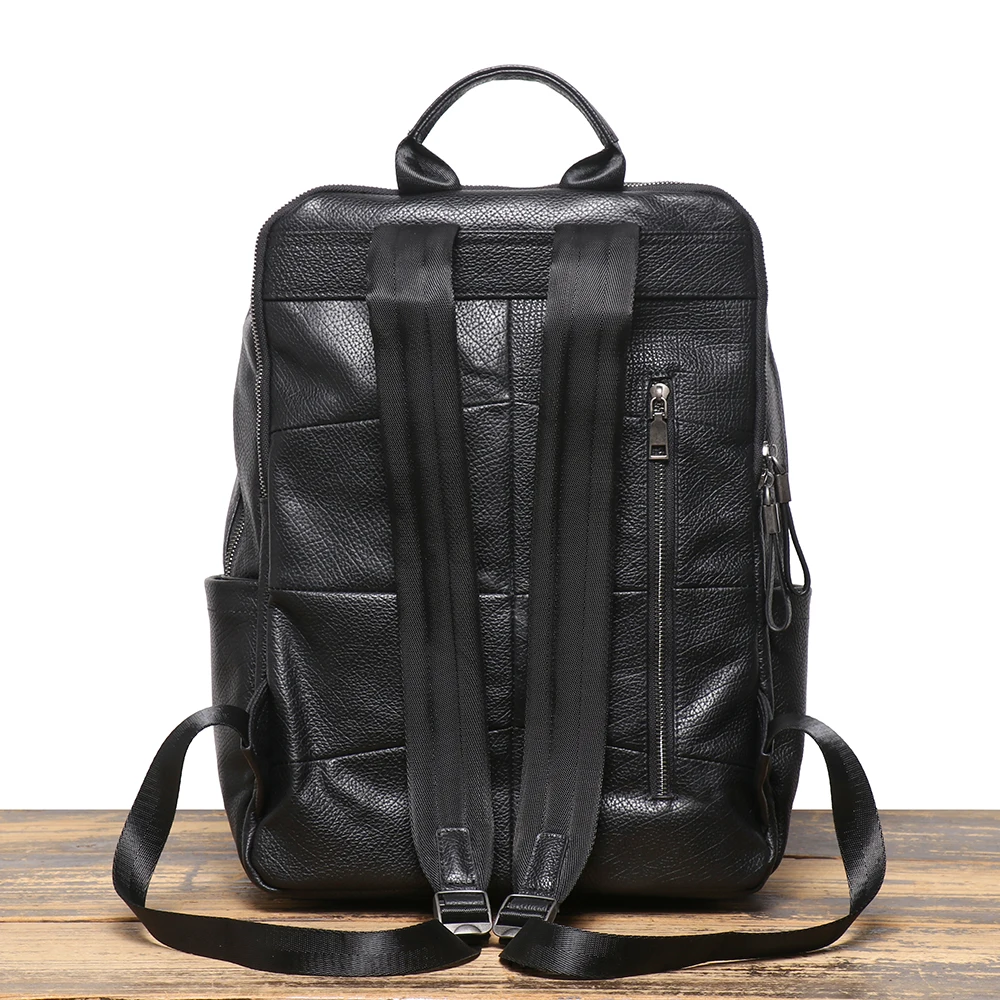
Optimal Dimensions for Airline-Compliant Leather Backpacks
Finding the sweet spot for leather backpack dimensions involves balancing maximum capacity with universal compliance. Based on comprehensive airline data, these dimensions offer the best chance of approval across most carriers:
- Height: 20-21 inches (50-53 cm)
- Width: 13-14 inches (33-35 cm)
- Depth: 8-9 inches (20-22 cm)
- Total linear inches: 42-44 inches (106-112 cm)
These dimensions allow for a capacity of 30-40 liters, which provides ample packing space while maintaining compliance. Carry-on leather backpacks in this size range offer the best balance between capacity and regulations.
When selecting a backpack, remember that shape matters as much as raw dimensions. A boxier shape maximizes usable space but may appear larger during visual inspection. Conversely, a tapered or curved design may measure the same on paper but appear smaller to gate agents.
The ideal capacity for most travelers falls between:
– Weekend trips: 25-30 liters
– Week-long trips: 30-40 liters
– Extended travel: 40-45 liters (pushing limits but possible with careful packing)
Staying within these parameters ensures your leather backpack remains compliant while providing sufficient capacity for most travel needs.
Essential Features of Travel-Friendly Leather Backpacks
Beyond dimensions, specific features make leather backpacks more suitable for air travel:
Laptop Compartment
- Dedicated padded section positioned against your back
- Recommended dimensions: 15” × 10” × 1” (accommodates most laptops up to 15.6”)
- Easy access for security screening
- Protective padding on all sides, especially bottom
Organization Systems
- Multiple compartments rather than one large cavity
- Quick-access pockets for travel documents and electronics
- Internal compression straps to secure contents
- Hidden security pockets for valuables
Comfort Features
- Padded shoulder straps at least 2” wide to distribute weight
- Sternum strap to offset leather’s additional weight
- Ventilated back panel to prevent overheating
- Padded handle for alternative carrying options
Security Elements
- Lockable YKK zippers compatible with TSA-approved locks
- RFID-blocking pockets for passport and credit cards
- Hidden seam pockets for emergency cash
- Water-resistant exterior or included rain cover
Proper conditioning of leather backpacks ensures these features remain functional throughout the bag’s lifetime. Regular maintenance preserves structural integrity, keeps zippers operating smoothly, and protects electronics stored inside.
Soft vs. Structured Leather: Which Design Meets Airline Requirements Better?
Leather backpacks generally fall into two design categories, each with distinct advantages for air travel:
| Design Type | Pros for Air Travel | Cons for Air Travel |
|---|---|---|
| Soft Leather | – Compresses to fit tight spaces – Conforms to irregular overhead bins – Typically lighter weight – Can squeeze into sizer bins | – Less protection for contents – May bulge beyond stated dimensions – Less organized internal space – Can lose shape over time |
| Structured Leather | – Maintains shape regardless of contents – Better protection for electronics – More organized internal space – Professional appearance – Contents less likely to shift | – Cannot compress to fit tight spaces – Typically heavier – Rigid shape may fail sizer tests – Less forgiving in crowded bins |
For frequent travelers, full-grain leather backpacks with semi-structured designs offer the best compromise. This construction provides enough structure to protect contents while maintaining some flexibility for fitting into sizers and bins.
When selecting between designs, consider your typical travel patterns:
– Business travelers generally benefit from structured designs that maintain professionalism and protect electronics
– Adventure travelers might prefer softer designs that adapt to various transportation methods
– Weekend travelers can choose either style based on personal preference and specific airline requirements
The ideal design often combines elements of both: reinforced back and bottom panels for structure and protection, with slightly softer sides that can compress when needed.
Top Airline-Compliant Leather Backpack Models
These leather backpack models consistently meet airline requirements while offering superior functionality for travelers:
Heritage Traveler 35L
– Dimensions: 20” × 13” × 8” (41 linear inches)
– Weight: 3.2 lbs empty
– Capacity: 35 liters
– Key features: Full-grain leather, dedicated 15” laptop compartment, clamshell opening for easy packing, water-resistant treatment
– Best for: Business travelers seeking a professional appearance with practical features
Venture Explorer 40L
– Dimensions: 21” × 14” × 9” (44 linear inches)
– Weight: 3.8 lbs empty
– Capacity: 40 liters
– Key features: Weather-resistant top-grain leather, expandable side pockets, front organizer panel, multiple carrying options
– Best for: Extended trips requiring maximum allowed carry-on capacity
Weekender Compact 28L
– Dimensions: 19” × 12” × 8” (39 linear inches)
– Weight: 2.9 lbs empty
– Capacity: 28 liters
– Key features: Soft-sided full-grain leather, compression straps, minimalist design, converts from backpack to tote
– Best for: Short trips and compliance with stricter international airlines
Executive Commuter 32L
– Dimensions: 20” × 13” × 8” (41 linear inches)
– Weight: 3.4 lbs empty
– Capacity: 32 liters
– Key features: Semi-structured design, RFID-blocking pocket, external USB charging port, luggage pass-through
– Best for: Business travelers with electronics and organization needs
Adventure Rogue 38L
– Dimensions: 21” × 14” × 8” (43 linear inches)
– Weight: 3.6 lbs empty
– Capacity: 38 liters
– Key features: Distressed leather, waterproof base, external gear attachment points, expandable capacity
– Best for: Adventure travelers needing versatility and weather resistance
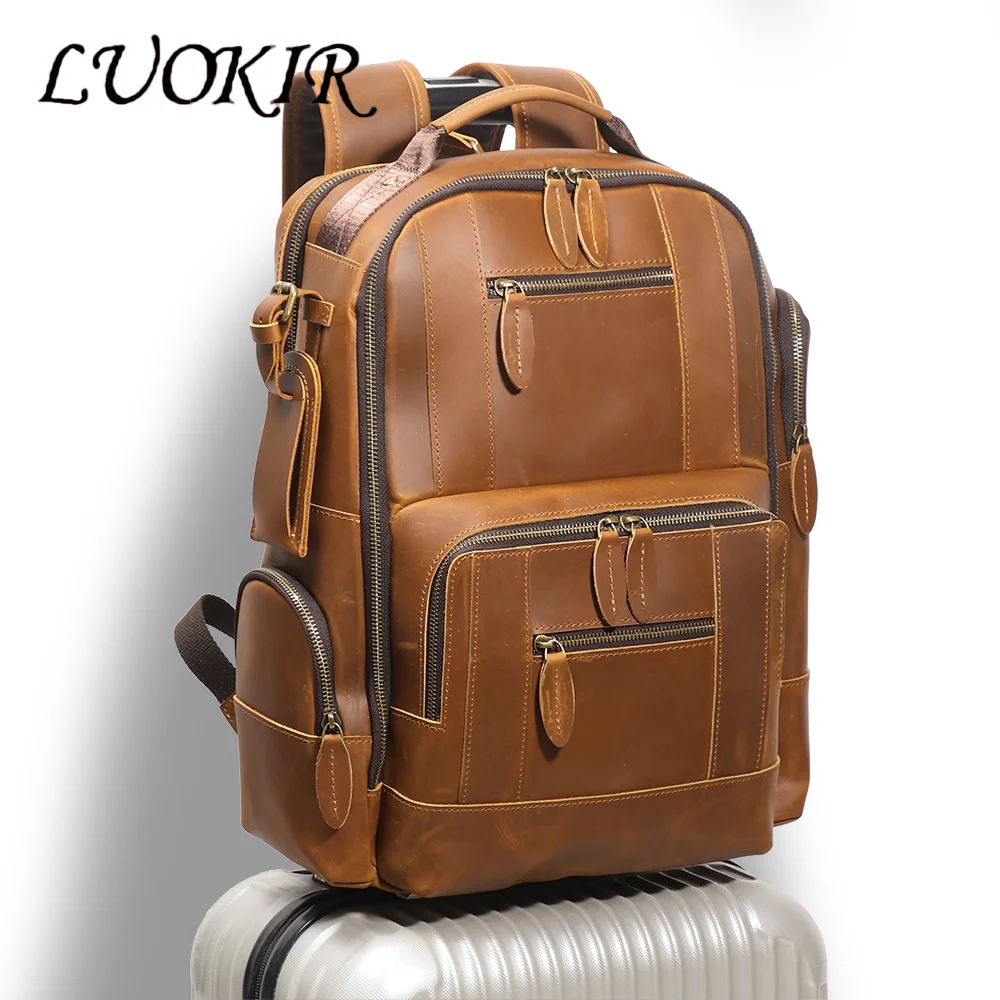
Each of these models maintains compliance with major airlines while offering unique advantages for different travel styles. The ideal choice depends on your typical trip length, items you regularly pack, and personal style preferences.
Men’s leather travel backpacks typically feature slightly more angular designs and neutral color options, though the dimensions and features remain consistent with the models listed above.
Carry On Leather Backpack, Roll Top Leather Backpack
Price range: $77.76 through $96.48 Select options This product has multiple variants. The options may be chosen on the product page17 Inch Leather Laptop Backpack, Men's Leather Travel Backpack, Men's Leather Work Backpack
Price range: $106.28 through $143.88 Select options This product has multiple variants. The options may be chosen on the product pageFull Grain Leather Backpack, Men's Leather Laptop Backpack, Men's Leather Work Backpack
$353.46 Select options This product has multiple variants. The options may be chosen on the product page15 Inch Leather Laptop Backpack, Carry On Leather Backpack
Price range: $136.84 through $139.88 Select options This product has multiple variants. The options may be chosen on the product page- $123.08 Select options This product has multiple variants. The options may be chosen on the product page
Women's Leather Backpack, Women's Leather Travel Backpack
$117.64 Select options This product has multiple variants. The options may be chosen on the product page
Strategic Packing Techniques for Leather Carry-Ons
Maximizing space while maintaining shape is particularly important with leather backpacks. Follow these packing strategies to optimize your leather carry-on:
- Bottom Layer – Place heavier items (shoes, toiletry kits) at the bottom for stability
- Middle Layer – Roll softer clothing items (t-shirts, underwear) and pack tightly in the middle
- Top Layer – Place easily wrinkled items (dress shirts, blouses) folded with tissue paper on top
- External Pockets – Store frequently needed items (documents, electronics, snacks) in outer compartments
Proper weight distribution is crucial for leather backpacks:
– Heaviest items closest to your back
– Medium-weight items in the middle
– Lightweight items furthest from your back
– Even distribution between left and right sides
For security checkpoints, organize your backpack for easy access:
– Keep electronics in dedicated sleeves for quick removal
– Use clear pouches for liquids and small electronics
– Keep documents in easily accessible but secure pockets
– Avoid overpacking to ensure smooth re-packing after screening
Understanding efficient packing techniques for leather carry-ons helps maximize space while maintaining the bag’s shape and protecting the leather from stress points. This approach ensures your backpack remains compliant while accommodating all necessary items.
Managing Airline Sizer Tests and Gate Checks
The dreaded airline sizer box is the final judge of your backpack’s compliance. Understanding this process helps ensure your leather backpack stays with you in the cabin:
- Sizer dimensions are often slightly smaller than stated maximums to account for wheels and handles
- Enforcement varies dramatically between airlines, airports, and even individual staff members
- Gate agents typically look for obviously oversized bags rather than measuring each one
- Fees for gate-checked bags range from $30 to $75 depending on the airline and route
Strategies for successful sizer tests include:
- Compress your backpack using all available straps before approaching the gate
- Wear bulky clothing items instead of packing them if you’re concerned about size
- When placing in a sizer, slide in bottom-first with the back panel facing outward
- If questioned, demonstrate that the bag can compress to fit requirements
- Remain polite and cooperative with staff – confrontation rarely results in exceptions
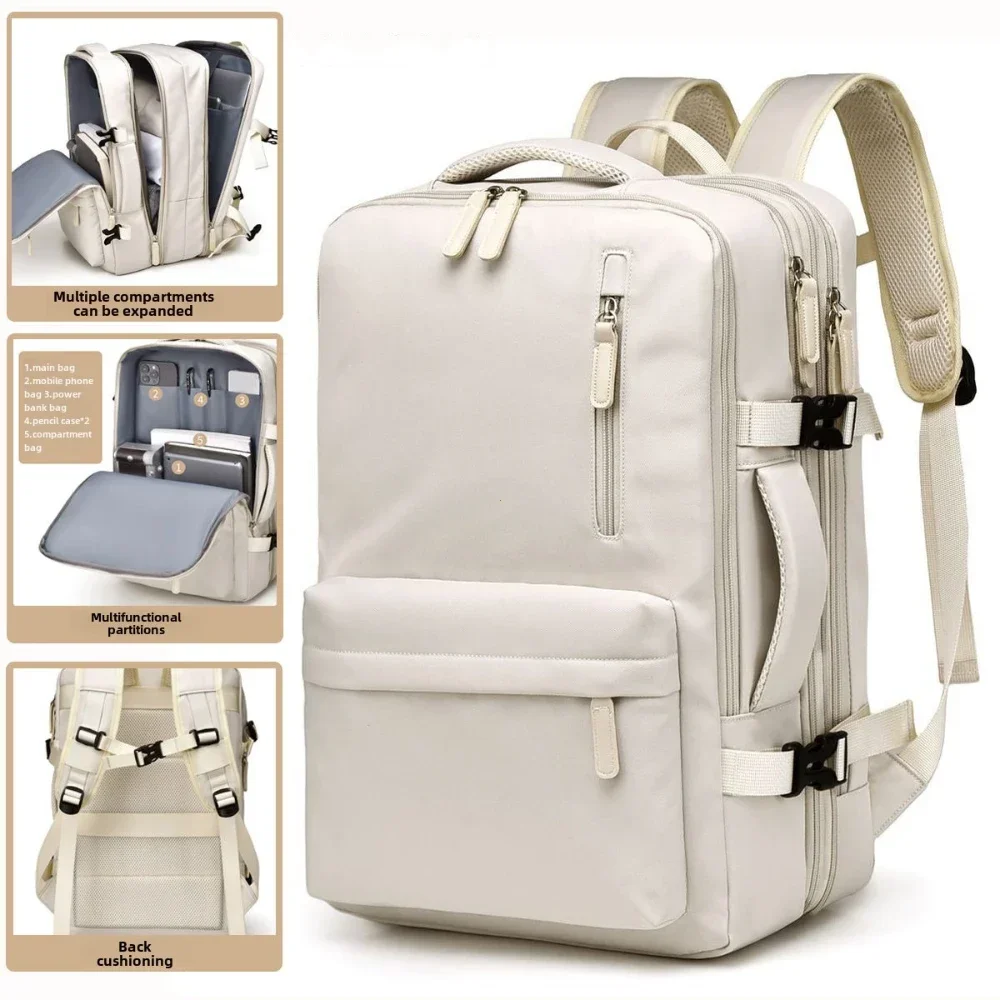
If your bag is slightly over the limit, you might consider removing a few items temporarily (perhaps into a shopping bag or jacket pockets) until after boarding. Once on the plane, these can be returned to your backpack.
When faced with a gate check situation, quickly remove valuables, electronics, and fragile items to keep with you before surrendering your bag.
Special Considerations for Different Travel Scenarios
Different travel scenarios require adaptations to your leather backpack strategy:
International vs. Domestic Travel
International carriers generally enforce stricter weight limits (often 15-22 lbs) compared to domestic airlines. For international travel:
– Pack lighter items or fewer items
– Consider a slightly smaller backpack (30-35L vs. 40L)
– Be prepared for more frequent weighing of carry-ons
– Research airline-specific policies before booking
Business vs. Leisure Travel
Business travelers typically need more organization for electronics and documents but fewer clothing items, while leisure travelers need more versatile storage:
– Business: Focus on backpacks with dedicated electronics storage and wrinkle-preventing features
– Leisure: Prioritize flexible main compartments and external attachment points
Short vs. Extended Trips
- Weekend trips: 25-30L backpacks with minimal organization
- Week-long trips: 30-40L backpacks with compression systems
- Extended trips: Consider a leather backpack for electronics and valuables plus a lightweight secondary bag for clothing
Women’s leather travel backpacks often feature thoughtfully designed organizational systems that adapt well to these various travel scenarios, with dimensions carefully calibrated for proper weight distribution.
Maintaining Your Leather Backpack During Travel
Travel presents unique challenges for leather care. Protect your investment with these essential practices:
- Apply leather conditioner 1-2 days before travel to allow absorption
- Carry a small leather care kit (mini conditioner, water repellent, microfiber cloth)
- Address spills and water exposure immediately by blotting (never rubbing)
- Keep leather backpacks away from direct heat sources when drying
- Store your backpack properly in hotel rooms (hung up or on a clean surface, not floor)
- Use a rain cover in wet conditions to prevent water absorption
For different climate conditions:
– Dry climates: Apply conditioner more frequently to prevent cracking
– Humid environments: Allow proper air circulation when storing to prevent mold
– Cold conditions: Warm leather gradually when moving between temperature extremes
– Hot conditions: Apply sun protection products to prevent fading
Waterproofing your leather bag is especially important for travel, as you’ll likely encounter unexpected weather. Using appropriate products ensures protection without damaging the leather’s natural properties.
After your trip, thoroughly clean and condition your backpack before storage to address any travel-related wear and extend its lifespan.
Frequently Asked Questions About Leather Carry-On Backpacks
Can a 50L leather backpack qualify as a carry-on?
Most 50L backpacks exceed standard carry-on dimensions. However, if the backpack has compression features and is made of soft leather that can reduce to approximately 45L when compressed, it might pass on less strict airlines. For reliable compliance, stay under 45L capacity.
Are leather backpacks significantly heavier than synthetic alternatives?
Yes. A typical full-grain leather backpack weighs 2.5-4 pounds empty, while comparable synthetic backpacks weigh 1-2 pounds. This difference is significant when dealing with airlines that have weight restrictions.
How do I ensure my leather backpack fits in an airline sizer?
Pack strategically to maintain a rectangular shape, use all compression straps, and insert the bag back-panel first into the sizer. If it’s a soft leather design, gently compress while inserting.
What’s the best way to clean my leather backpack after travel?
Wipe with a slightly damp cloth, focus on any stained areas with appropriate leather cleaner, allow to dry naturally away from heat sources, then apply conditioner. DIY leather care techniques can be particularly useful for maintaining your backpack during and after travel.
Can I use a leather backpack as a personal item instead of a carry-on?
Yes, if the dimensions are appropriate. A smaller leather backpack (15-18L capacity) measuring approximately 16” × 12” × 6” will qualify as a personal item on most airlines, allowing you to bring another carry-on as well.
How do compression straps affect airline compliance?
Compression straps can reduce a backpack’s depth by 1-2 inches when fully tightened, potentially bringing a slightly oversized bag into compliance. However, the bag must still be capable of fitting into the sizer without force.
What should I do if my leather backpack is slightly oversized?
If your backpack exceeds dimensions by only 1-2 inches, use compression straps, pack lighter to reduce bulging, and maintain a low profile at the gate. Consider checking in online and avoiding checking in luggage to minimize scrutiny of your carry-on.
How do leather backpacks handle overhead bin compression?
Premium full-grain leather is surprisingly resilient to compression. While structured leather backpacks protect contents better, semi-structured designs offer the best combination of protection and flexibility for fitting into crowded overhead bins.
